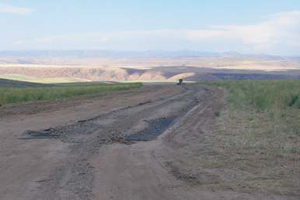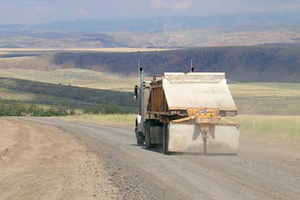 |
For the construction of Idaho’s largest wind farm, haul roads needed to be built. More than fifty percent of the wind farm’s 100 turbines had to be completed by December, and with only a few months remaining in the year a solution was needed that would allow the construction of this project to continue, in spite of the site’s unfavorable soil conditions.
The ground throughout the Wolverine Creek Wind Farm in Idaho Falls was dry and silty. These conditions created a weak foundation for the constant heavy traffic that would be accessing the location. Without proper support for the construction equipment rutting would be inevitable, adding delays to the already tight development schedule.
An unreinforced roadway with significantly thicker aggregate was considered, but that solution was considered prohibitive for time and cost.
A detailed analysis of possible solutions was performed using SpectraPave2™ Software, a design program from Tensar International. (The company’s most current version of this frequently updated software is SpectraPave4™.) Incorporating Tensar® geogrids was the best choice for meeting the owner’s goal of completing Phase One on schedule. The Tensar geogrid was recommended for placement under a ten- inch aggregate layer to create a stable and strong platform for the heavily-laden trucks continually accessing the wind farm site.
The installation of geogrid in the subgrade would allow more truck passes, without road failure and with less aggregate than the original design had mandated.
Today, the Wolverine Creek Wind Farm continues to perform well. Its 43 1.5-megawatt turbines produce 64.5-megawatts.
Saving Time, Money and Environmental Disturbance
The Spectra System gave the Wolverine Creek Wind Farm and its surrounding communities several advantages. In addition to meeting their deadline, the integration of these geogrids allowed construction to continue, despite the traffic’s heavy loads. Due to the eight-inch reduction in the required thickness of the aggregate layer, a savings of over $32,000 was achieved.
This reduction of aggregate also meant less truck traffic across the site and its surrounding areas, which resulted in less disturbance to the environment and to local residents.
PROJECT DETAILS
Owner/Developer: Invenergy, LLC; Wolverine Creek Energy LLC
Civil Engineer: Schiess and Associates
General Contractors: Tennessee Valley Infastructure Group; Eagle Rock Timber Company
Product/System: Spectra® Roadway Improvement System
Geogrid: Tensar Geogrid, 45,000 yd2
This project story comes from Tensar International. Learn more about Tensar’s technologies at www.tensarcorp.com. A copy of the original project story is available (PDF).













